外研版(2019)必修第三册 Unit6 Disaster and hope Using Language-listening and speaking 名师课件(共25张PPT)
文档属性
| 名称 | 外研版(2019)必修第三册 Unit6 Disaster and hope Using Language-listening and speaking 名师课件(共25张PPT) | 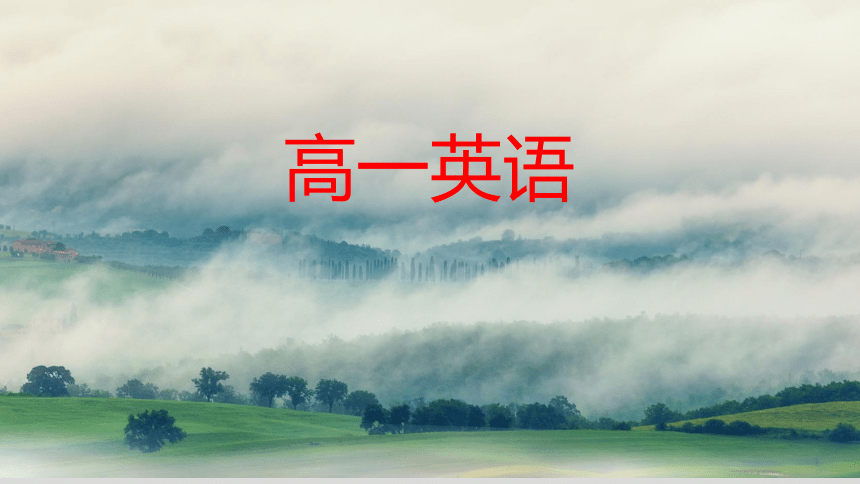 | |
| 格式 | pptx | ||
| 文件大小 | 7.4MB | ||
| 资源类型 | 教案 | ||
| 版本资源 | 外研版(2019) | ||
| 科目 | 英语 | ||
| 更新时间 | 2023-03-02 07:46:29 | ||
图片预览

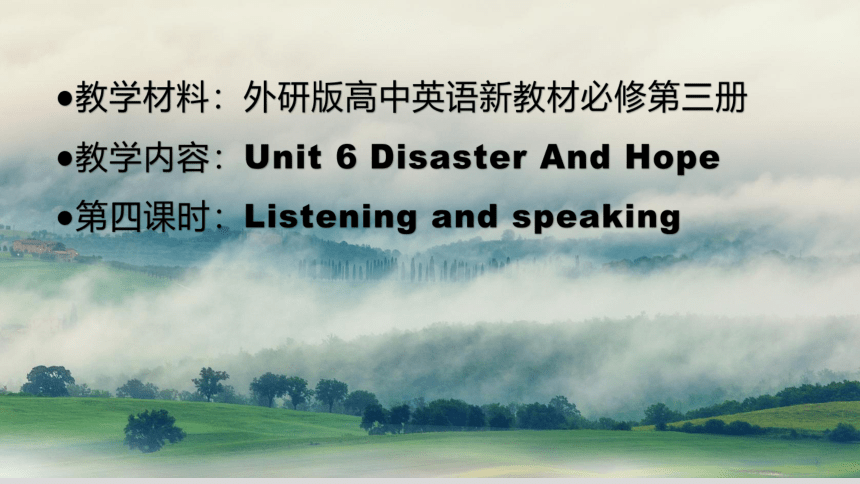
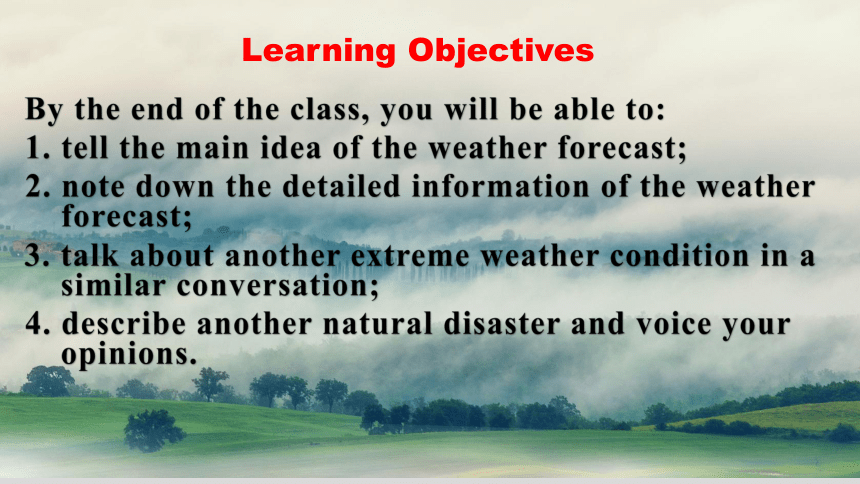
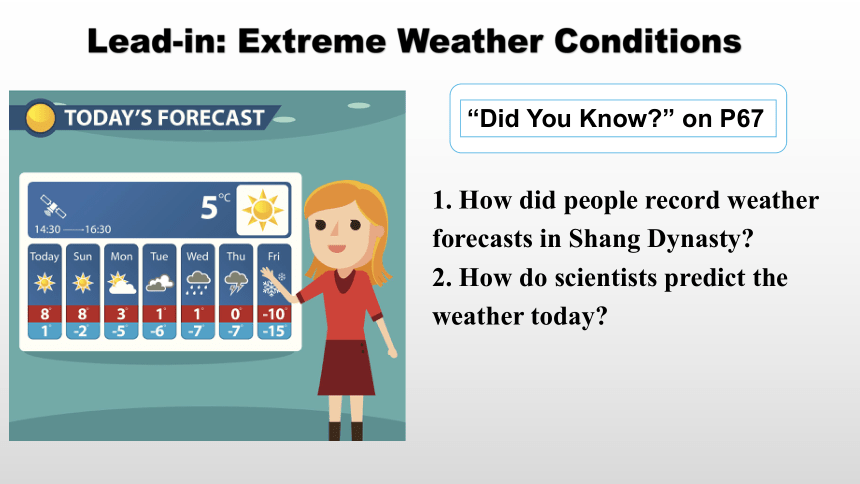
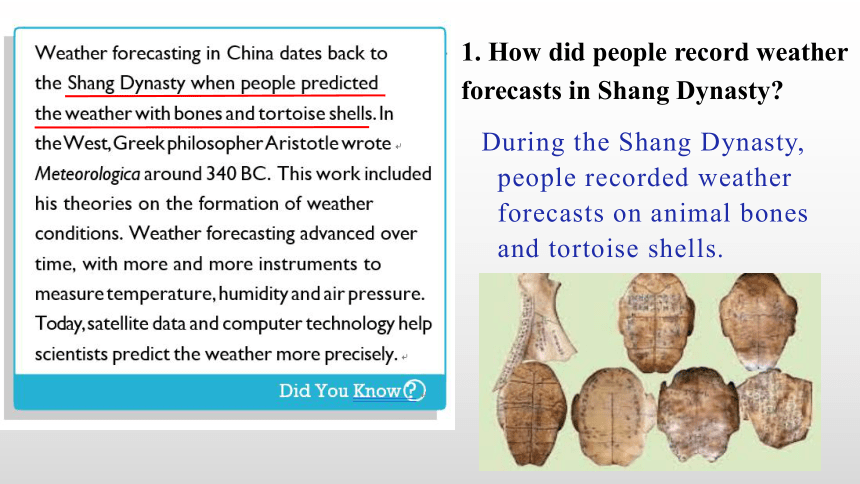
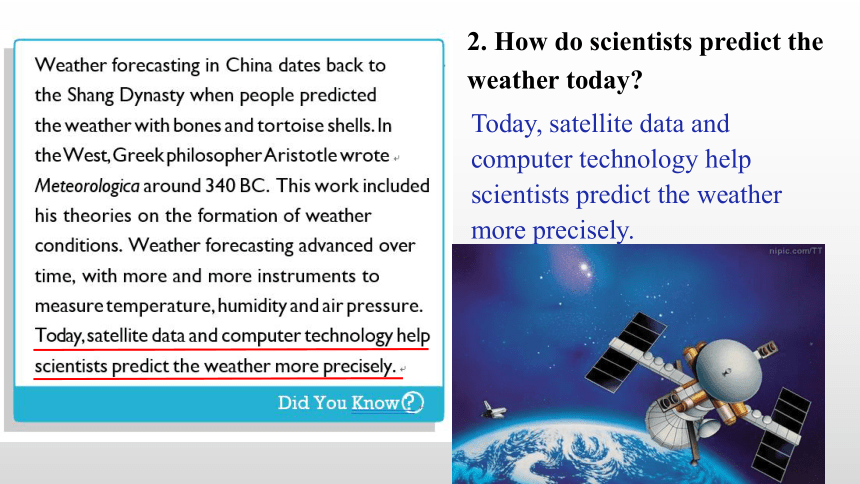
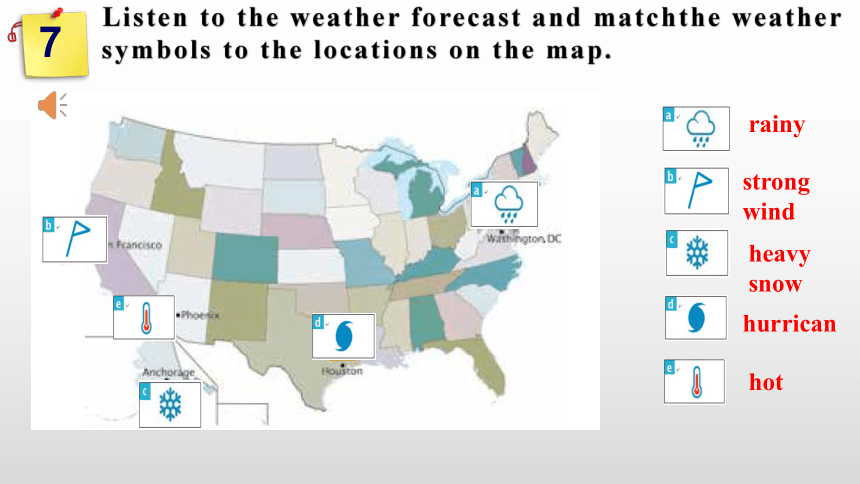
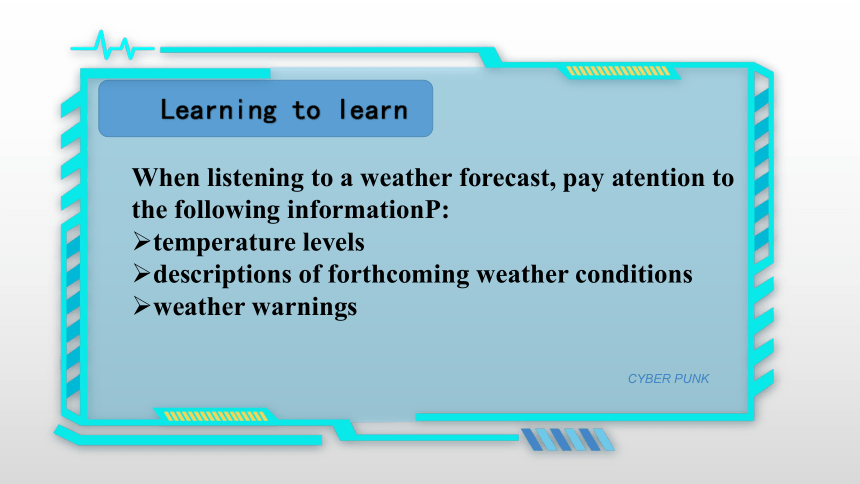
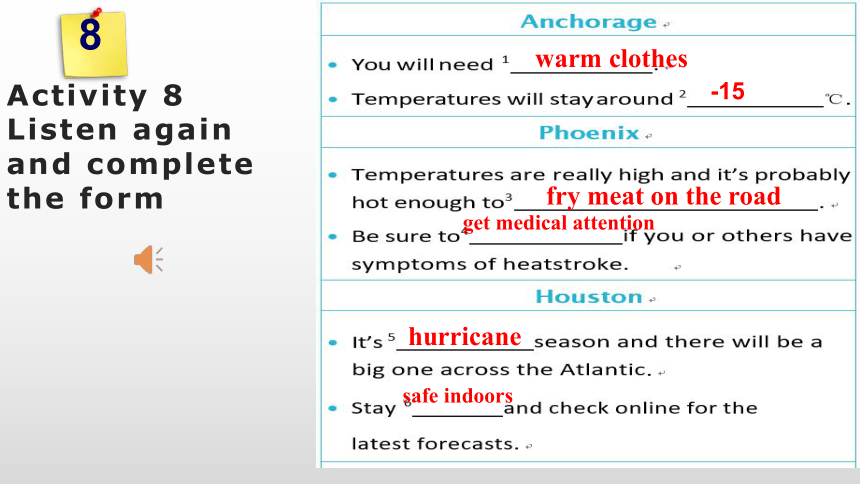
文档简介
(共25张PPT)
高一英语
教学材料:外研版高中英语新教材必修第三册
教学内容:Unit 6 Disaster And Hope
第四课时:Listening and speaking
Learning Objectives
By the end of the class, you will be able to:
1. tell the main idea of the weather forecast;
2. note down the detailed information of the weather forecast;
3. talk about another extreme weather condition in a similar conversation;
4. describe another natural disaster and voice your opinions.
1. How did people record weather forecasts in Shang Dynasty
2. How do scientists predict the weather today
Lead-in: Extreme Weather Conditions
“Did You Know ” on P67
During the Shang Dynasty, people recorded weather forecasts on animal bones and tortoise shells.
1. How did people record weather forecasts in Shang Dynasty
2. How do scientists predict the weather today
Today, satellite data and computer technology help scientists predict the weather more precisely.
Listen to the weather forecast and matchthe weather symbols to the locations on the map.
7
rainy
strong
wind
heavy
snow
hurrican
hot
Learning to learn
CYBER PUNK
When listening to a weather forecast, pay atention to the following informationP:
temperature levels
descriptions of forthcoming weather conditions
weather warnings
Activity 8
Listen again
and complete the form
warm clothes
-15
fry meat on the road
get medical attention
hurricane
safe indoors
8
13
through floodwaters
25
wildfires
Activity 8
Listen again
and complete the form
8
Now read the weather forecast yourself again and take notes on the expressions used to describe the weather.
Activity
Work in pairs. Act out the conversation to talk about an extreme weather condition.
Student A: Turn to Page 83.
Student B: Turn to Page 86.
9
Student A
You learn from a TV report that Student B’s city has been suffering from rainstorms and floods. Call student B to check if he / she is safe and ask about the weather. Information you’d like to know:
how long the rainstorms have lasted;
the effect of the rainstorms on his / her city;
how to cope during rainstorms and floods;
what you can do to help;
how the weather has changed over recent years.
Speaking
9
Student A
Useful expressions
9
Learning to learn
I’m calling to check that…
How long have… lasted
What’s the effect of…
How do you cope with…
Is there anything I can do to…
How has the weather changed…
Student B
Your city has been suffering from rainstorms and floods. Student A
calls you to check you are safe and ask about the weather. Give
him / her the information.
Duration: about five days;
Effect: no electricity; shortage of food and drinking water; damage to property.
Points for attention: stay away from fallen power lines, particularly in or near water; move to higher ground, away from the flow of water.
Things to help: make a donation; volunteer to help people in need; share knowledge on how to prevent disease.
Changes to the weather: more frequent extreme weather conditions; more severe rainstorms and floods.
9
Student B
Useful expressions
9
Thank you for…
The… have lasted…
The most serious effect is…
Be sure to…
I’d really appreciate it if you would…
There have been more…
I’m calling to check that…
How long have… lasted
What’s the effect of…
How do you cope with…
Is there anything I can do to…
How has the weather changed…
Thank you for…
The… have lasted…
The most serious effect is…
Be sure to…
I’d really appreciate it if you would…
There have been more…
A
B
ACT IT OUT!
REC
HD
4K
25FPS
MENU
Activity 4 Look at the pictures
Which one do you think is the most dangerous
Can you name some big natural disasters in history
Answering the questions
1. Which one do you think is the most dangerous
I think earthquake is the most dangerous because it can cause great damage to human beings.
2. Can you name some big natural disasters in history
Some natural disasters in history including:
the 1976 Tangshan earthquake;
the 8.1-magnitude earthquake hit Nepal in 2015;
the Indian Ocean Tsunami in 2004…
Activity 5: Complete the reports
typhoon
wildfire
avalanches
earthquake
tsunami
blizzard
drought
Summarize the words describing natural disasters
Homework
Option 1: Write a similar conversation to talk about another extreme weather condition, using what you have learnt in this session.
Option 2: Talk about a recent natural disaster you have heard about or seen on the news and voice your opinion.
Thank You
高一英语
教学材料:外研版高中英语新教材必修第三册
教学内容:Unit 6 Disaster And Hope
第四课时:Listening and speaking
Learning Objectives
By the end of the class, you will be able to:
1. tell the main idea of the weather forecast;
2. note down the detailed information of the weather forecast;
3. talk about another extreme weather condition in a similar conversation;
4. describe another natural disaster and voice your opinions.
1. How did people record weather forecasts in Shang Dynasty
2. How do scientists predict the weather today
Lead-in: Extreme Weather Conditions
“Did You Know ” on P67
During the Shang Dynasty, people recorded weather forecasts on animal bones and tortoise shells.
1. How did people record weather forecasts in Shang Dynasty
2. How do scientists predict the weather today
Today, satellite data and computer technology help scientists predict the weather more precisely.
Listen to the weather forecast and matchthe weather symbols to the locations on the map.
7
rainy
strong
wind
heavy
snow
hurrican
hot
Learning to learn
CYBER PUNK
When listening to a weather forecast, pay atention to the following informationP:
temperature levels
descriptions of forthcoming weather conditions
weather warnings
Activity 8
Listen again
and complete the form
warm clothes
-15
fry meat on the road
get medical attention
hurricane
safe indoors
8
13
through floodwaters
25
wildfires
Activity 8
Listen again
and complete the form
8
Now read the weather forecast yourself again and take notes on the expressions used to describe the weather.
Activity
Work in pairs. Act out the conversation to talk about an extreme weather condition.
Student A: Turn to Page 83.
Student B: Turn to Page 86.
9
Student A
You learn from a TV report that Student B’s city has been suffering from rainstorms and floods. Call student B to check if he / she is safe and ask about the weather. Information you’d like to know:
how long the rainstorms have lasted;
the effect of the rainstorms on his / her city;
how to cope during rainstorms and floods;
what you can do to help;
how the weather has changed over recent years.
Speaking
9
Student A
Useful expressions
9
Learning to learn
I’m calling to check that…
How long have… lasted
What’s the effect of…
How do you cope with…
Is there anything I can do to…
How has the weather changed…
Student B
Your city has been suffering from rainstorms and floods. Student A
calls you to check you are safe and ask about the weather. Give
him / her the information.
Duration: about five days;
Effect: no electricity; shortage of food and drinking water; damage to property.
Points for attention: stay away from fallen power lines, particularly in or near water; move to higher ground, away from the flow of water.
Things to help: make a donation; volunteer to help people in need; share knowledge on how to prevent disease.
Changes to the weather: more frequent extreme weather conditions; more severe rainstorms and floods.
9
Student B
Useful expressions
9
Thank you for…
The… have lasted…
The most serious effect is…
Be sure to…
I’d really appreciate it if you would…
There have been more…
I’m calling to check that…
How long have… lasted
What’s the effect of…
How do you cope with…
Is there anything I can do to…
How has the weather changed…
Thank you for…
The… have lasted…
The most serious effect is…
Be sure to…
I’d really appreciate it if you would…
There have been more…
A
B
ACT IT OUT!
REC
HD
4K
25FPS
MENU
Activity 4 Look at the pictures
Which one do you think is the most dangerous
Can you name some big natural disasters in history
Answering the questions
1. Which one do you think is the most dangerous
I think earthquake is the most dangerous because it can cause great damage to human beings.
2. Can you name some big natural disasters in history
Some natural disasters in history including:
the 1976 Tangshan earthquake;
the 8.1-magnitude earthquake hit Nepal in 2015;
the Indian Ocean Tsunami in 2004…
Activity 5: Complete the reports
typhoon
wildfire
avalanches
earthquake
tsunami
blizzard
drought
Summarize the words describing natural disasters
Homework
Option 1: Write a similar conversation to talk about another extreme weather condition, using what you have learnt in this session.
Option 2: Talk about a recent natural disaster you have heard about or seen on the news and voice your opinion.
Thank You
